Invasion America
By Fred W. Manzo
Fortress America
Fortress America is a game with an interesting history. If you go back far enough it was obviously inspired by a game published in 1976 by that sainted company SPI and called Invasion America. This was an old-school hex-and-counter game designed by the legendary Jim Dunnigan himself. It used a map that covered all of mainland USA, most of Mexico and parts of Canada. The last time I played it was at FatDog about 8 years ago.
Fortress America, itself, was published by Milton Bradley as part of their Gamemaster series, which included such well-known games as Axis and Allies, Shogun, Conquest of the Empire and Broadsides and Boarding Parties.
Milton Bradley, however, took a different approach than SPI. The hexes were gone as were the cardboard counters. The rules were simpler and there was no case numbering, exception listing or cross-referencing. FA came in two printings, the first had Saddam Hussein on the cover and the second had him “in disguise” with a beard. In any case, it won the Charles S. Robert award as the best 20th century game of 1986.
The turn sequence is found in the upper left-hand corner of the player’s aid card, the “CRT” is in its lower right and the dice symbols are located in its upper right.
As for the “Hit chart,” it’s important to realize that there is a priority to how hits may be apportioned. For example, infantry and partisans must hit other foot soldiers if possible.
The Turn Sequence in Fortress America is as follows:
1. Reinforcements
2. Declare battles
3. Maneuvers (first movement – but not for infantry)
4. Fire lasers (US)
5. Combat
6. Invasion (second movement)
7. Supply check (for Invaders)
8. Capture territories
So, players must declare which areas they will attack before they move and infantry does not move in the first phase.
The last edition of Fortress America was published without major changes by Fantasy Flight Games only a few years ago. Both versions were designed by Michael Gray and take about 2 1/2 hours to play. The only differences are:
A. The invaders now have their own cards and sometimes get reinforcements above their starting horde. In this version, the invaders may bring in 8 reinforcements a turn as normal or 5 plus a random reinforcement card. These cards do vary in importance so when chosen the invaders are gambling they are worth more than 3 figures.
While some are quite powerful, for example, there is a card that places an overlay on the map that permits invaders to parachute new units inland and another that allows western invader helicopters to transport infantry, there are others that are for all practical purposes worthless.
B. Mobile units transport infantry. This is especially important for the western invader as he was burdened by slow-moving infantry to a greater degree than his partners. What happened prior to this improvement was that his army would split in two shortly after the invasion with slower infantry garrisoning coastal territories and high-value units leading assaults. This put him in something of a bind. He had no combined arms bonus when fighting through the Rockies and no infantry units on his front lines to absorb partisan and enemy infantry hits. Fast moving infantry turns all this around.
C. A couple of cities in the east have been de-listed (E.G., Buffalo) and a couple of cities in the far west have been promoted. This gives the western invader something interesting to aim for in turns 2 and 3. And, in any case, if the invaders ever reach the Buffalo area the game is over with or without a city being there. So removing Buffalo itself didn’t strategically change anything. Although the promotion of Las Vegas and Colorado Springs does tilt the game somewhat in the invaders favor as they now have additional, reachable targets.
D. Most dice now have symbols, not numbers. This simplifies the situation when attackers with combined arms assault city/mountain areas.
E. The game definitely ends after turn 10. Although I have no idea how important this is as all our games end in concessions by turn 6 or 7.
Fortress America is one of our group’s favorite light wargames. It requires some tactics and some experience but it doesn’t demand an awful lot of thought.
It’s essentially an area movement game in which the US player faces three cooperating invaders. In the first edition, they were called the Asian Peoples Alliance (the western invaders), the Central American Federation (the southern invaders) and the Euro-Socialist Pact (the eastern invaders). Though why the US or the invaders don’t use nuclear weapons is a bit vague. Something about the Star Wars space-based system making ICBMs obsolete. (Anyone who then asks why they aren’t delivered by heavy bombers is putting way too much thought into this game.)
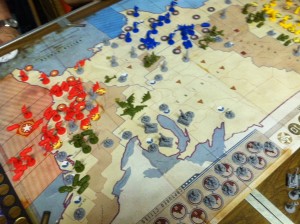
A view of the board from the Canadian border.The circular figures in the lower part of the picture are captured cities.
Anyway, FA starts with a weak conventionally armed USA being invaded by three co-operating factions. (There are rules to judge which invader did best, but everyone I’ve ever played with ignores this issue. They either all win or they all lose together.)
The Americans have 30 cities defended by 60 combat units and if 18 cities are captured they lose. The invaders, on the other hand, start with 60 combat units each, though after the first wave of 20 only 8 (or, in the last edition, 5 plus an invader card) can land per turn. So the US is outnumbered 3 to 1. But as the game heavily favors the defenders things are not as clear-cut as these numbers imply.
Combat units encompass infantry, mech forces (including mobile units – APCs – and hover tanks) and powerful air units (including helicopters and bombers). The Americans also have an ace in the hole in the form of laser towers that come online one per turn. They have an unlimited range and target individual enemy units. In addition, they hit 60 percent of the time. Their one great weakness being their inability to move, which turns them into primary targets for any invader’s spearhead divisions.
Though I must say, this whole laser tower thing is a nice touch. It increases the game’s tension at little cost and, unlike so many Euros, it makes turn 6 not anything like turn 1.
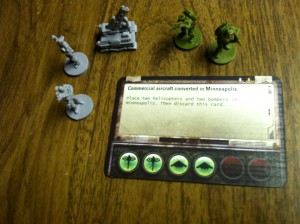
The green figures in the upper right of the photo are Americans regulars (second edition). The gray figures to the left are US partisans and a US laser cannon (with the rectangular base). The card generates random events.
The Americans also get 2 reinforcement / random event cards per turn plus one additional card for each city they re-capture. And these cards are of supreme importance. In fact, they are so important some American players intentionally put two or three high-value units on the invasion beaches. This way, although these units will undoubtedly be lost in turn one, they are ready to be called back to duty in turns two or three if one of the better reinforcement cards are drawn. (Without first turn losses of high-value units the first or second reinforcement card may turn out to be valueless). At least this way, the reinforcements can be placed where they are most needed. If they were not initially placed on the beaches they’d possibly be out of position and out of the game tactically until turn three. I don’t myself use this tactic but there are many people who do. I always felt garrisoning coastal cities only with infantry makes better sense.
Now, one of the charms of Fortress America is that although it’s a simple game it does have some depth.
For example, here are some tactics American players use:
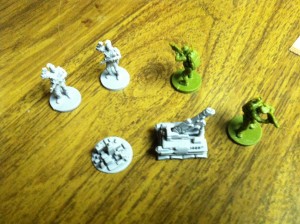
The gray figures are a city marker with a circular base and a U.S. partisan . The green figures are regular U.S. forces.
![]() They focus on recapture cities. Each re-capture results in one extra reinforcement card being drawn by the US player next turn. This is so important that if more than one or two cities are re-captured it’s more than likely the Americans will win.
They focus on recapture cities. Each re-capture results in one extra reinforcement card being drawn by the US player next turn. This is so important that if more than one or two cities are re-captured it’s more than likely the Americans will win.
In order to re-capture a city experienced players use their laser towers, card reinforcements, and counter-attacks in a concentrated effort. I’ve even seen American players withdraw from coastal cities entirely in the early going. For players who go this route, the thinking is something along these lines: the Americans aren’t interested in defending ever city, only in defending their 18th city (The last city that determines winners and losers). By withdrawing weak forces, even in cities, on the front line, the Americans preserve their forces for the important fights later on when the odds are not so lopsided. They are also spreading out the invaders, who now have to garrison these cities, and providing the Americans with a slew of captured cities to target. It’s simply better to re-capture a city then to hold it.
![]() They pick their shots. Normally, the defender eliminates the highest value target possible when he hits. But when defending cities this is not always the best idea. Many players instead concentrate their defensive fire on the rarest type of attacker in an effort to break his combined arms bonus. For example, say the attacker has targeted a key city. Perhaps he is bringing 2 infantry, 2 mobile units, 2 hover tanks, 2 helicopters and 2 bombers to the attack. Now, say the defender has only 2 infantry and 1 hover tank. The defender fires first and scores two hits, one by his infantry and one by his armor. As normal, the infantry eliminates an infantry unit, but the tank has a choice. It could eliminate an infantry or a mech unit if one is available (theoretically, he could choose to eliminate an air unit, if no infantry or mech units are left, but as careful attackers always make sure there are more ground units attacking then ground defenders this particular option is rarely usable.) Of course, most players in this situation have their armor eliminate the tank – the most valuable target possible. But some players realize the importance of holding key cities. So they eliminate attacking infantry instead and pick up the long-term advantage of breaking the attacker’s combined arms bonus. This way the attacker’s dice effectiveness has been degraded by about one third. And this might just be enough to hold the city. At least for this attack.
They pick their shots. Normally, the defender eliminates the highest value target possible when he hits. But when defending cities this is not always the best idea. Many players instead concentrate their defensive fire on the rarest type of attacker in an effort to break his combined arms bonus. For example, say the attacker has targeted a key city. Perhaps he is bringing 2 infantry, 2 mobile units, 2 hover tanks, 2 helicopters and 2 bombers to the attack. Now, say the defender has only 2 infantry and 1 hover tank. The defender fires first and scores two hits, one by his infantry and one by his armor. As normal, the infantry eliminates an infantry unit, but the tank has a choice. It could eliminate an infantry or a mech unit if one is available (theoretically, he could choose to eliminate an air unit, if no infantry or mech units are left, but as careful attackers always make sure there are more ground units attacking then ground defenders this particular option is rarely usable.) Of course, most players in this situation have their armor eliminate the tank – the most valuable target possible. But some players realize the importance of holding key cities. So they eliminate attacking infantry instead and pick up the long-term advantage of breaking the attacker’s combined arms bonus. This way the attacker’s dice effectiveness has been degraded by about one third. And this might just be enough to hold the city. At least for this attack.
![]() They use an all or nothing defense. That is, Fortress America does not allow blitz moves as does Axis and Allies. So, an empty area slows the attackers just as much as a weakly held one. Therefore, Americans typically fall back and clump there regular units in keys inland cities. (On the other hand, they also like to spread out their partisan units between these cities as they fire better dice when alone.)
They use an all or nothing defense. That is, Fortress America does not allow blitz moves as does Axis and Allies. So, an empty area slows the attackers just as much as a weakly held one. Therefore, Americans typically fall back and clump there regular units in keys inland cities. (On the other hand, they also like to spread out their partisan units between these cities as they fire better dice when alone.)
![]() They carefully pick areas to counter-attack. There are certain areas that are natural killing grounds. These include Washington DC and the area south-west of Atlanta. Both are close to the defender’s starting positions and may be attacked from two adjacent areas. If the Americans then throw in a laser, some bombers and attack from 2 directions, they can usually stop the eastern invaders cold.
They carefully pick areas to counter-attack. There are certain areas that are natural killing grounds. These include Washington DC and the area south-west of Atlanta. Both are close to the defender’s starting positions and may be attacked from two adjacent areas. If the Americans then throw in a laser, some bombers and attack from 2 directions, they can usually stop the eastern invaders cold.
![]() They use different strategies in different regions. Against the western invaders, players fall back trading space for time. Against the southern invader, the Americans usually fall back initially and then counter-attack their spearheads. (Once these are broken it takes the invaders much too long to bring up high-quality replacement units.)
They use different strategies in different regions. Against the western invaders, players fall back trading space for time. Against the southern invader, the Americans usually fall back initially and then counter-attack their spearheads. (Once these are broken it takes the invaders much too long to bring up high-quality replacement units.)
The invaders can win but they are on a tight schedule and anything that throws them off by even a turn or two can be fatal.
In the east, American players concentrate a majority of their laser targets and defend all their cities and mountain areas to the last unit. (There just isn’t any spare territory to fall back through. (Trading space for time not being an option on this front.) The eastern invader has the toughest job but then again he has the shortest route to multiple laser defended cities.
For the invaders, they:
![]() Carefully pick areas to invade. Normally, attacking players like to cut off any possibility of retreat before they launch an attack and they want at least three to one odds plus a combined arms bonus when attacking cities or mountain areas. The easiest way to generate these odds is to attack from two areas (each area has a 5 unit stacking limit) and bring in 5 bombers, which may overfly the defenders. And the easiest way to cut off the defender is to capture empty areas in his path of retreat via helicopter assaults.
Carefully pick areas to invade. Normally, attacking players like to cut off any possibility of retreat before they launch an attack and they want at least three to one odds plus a combined arms bonus when attacking cities or mountain areas. The easiest way to generate these odds is to attack from two areas (each area has a 5 unit stacking limit) and bring in 5 bombers, which may overfly the defenders. And the easiest way to cut off the defender is to capture empty areas in his path of retreat via helicopter assaults.
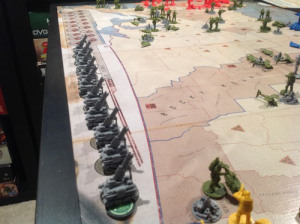
The latest edition lasers being lined up and ready to enter the game. One laser enters the game each turn. If the invaders do not win by turn 7 it’s highly unlikely they ever will.
![]() Capture American laser cities. Invaders usually use a broad front strategy in this effort whenever possible. This ensures their supply line remains unbroken and the longer the front line the more likely a few areas will be defended by only one or two, hopefully regular, units. These are easy targets and may not even cost casualties to over-run. Plus, the more areas conquered and the more units destroyed each turn, the easier it is to capture the all-important American laser cities later in the game.
Capture American laser cities. Invaders usually use a broad front strategy in this effort whenever possible. This ensures their supply line remains unbroken and the longer the front line the more likely a few areas will be defended by only one or two, hopefully regular, units. These are easy targets and may not even cost casualties to over-run. Plus, the more areas conquered and the more units destroyed each turn, the easier it is to capture the all-important American laser cities later in the game.
![]() Use different strategies in different regions of the country. The western invaders must move fast and take what loses that entails. They have the farthest to go before they break into high-value areas, so it’s important for them to use all the means at their disposal to move inland quickly. Eastern invaders, on the other hand, need to eliminate one or two enemy troop concentrations per turn. While southern invaders should attack troop concentrations AND push hard toward the mid-west cities.
Use different strategies in different regions of the country. The western invaders must move fast and take what loses that entails. They have the farthest to go before they break into high-value areas, so it’s important for them to use all the means at their disposal to move inland quickly. Eastern invaders, on the other hand, need to eliminate one or two enemy troop concentrations per turn. While southern invaders should attack troop concentrations AND push hard toward the mid-west cities.
![]() Always move (surplus) infantry inland as fast as possible. In the latest edition this means using mobile units to move them and for western invaders, this means using helicopters to transport them when the right invader card is drawn.
Always move (surplus) infantry inland as fast as possible. In the latest edition this means using mobile units to move them and for western invaders, this means using helicopters to transport them when the right invader card is drawn.
![]() Keep their bombers together and stationed in an off-shore invasion area as long as possible. This way only one bomber may be targeted by the American lasers per turn and none of the American reinforcement/random event cards can be used to eliminate them.
Keep their bombers together and stationed in an off-shore invasion area as long as possible. This way only one bomber may be targeted by the American lasers per turn and none of the American reinforcement/random event cards can be used to eliminate them.
![]() Limit the loss of high-value air units when attacking. That is, when attacking cities without defensive air cover they commit more ground units than the total number of defenders in the city. This way, any hits by the defenders must be taken against attacking ground units, not attacking aircraft.
Limit the loss of high-value air units when attacking. That is, when attacking cities without defensive air cover they commit more ground units than the total number of defenders in the city. This way, any hits by the defenders must be taken against attacking ground units, not attacking aircraft.
Anyway, Fortress America is now a light, area movement, dice heavy wargame that always draws 3 or 4 players whenever it is brought around.
Game Resources:


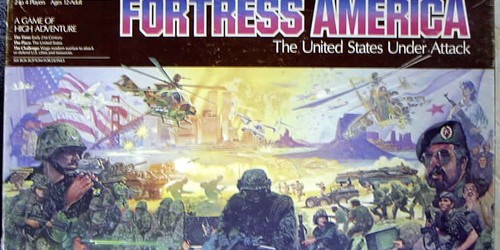
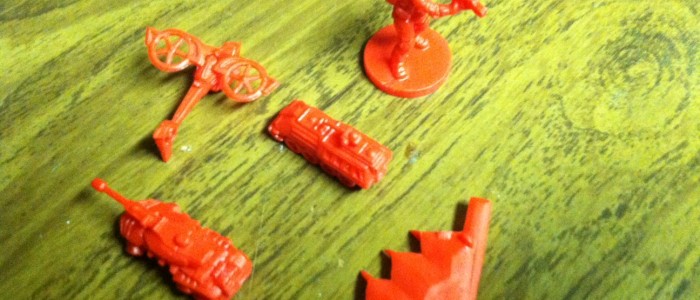
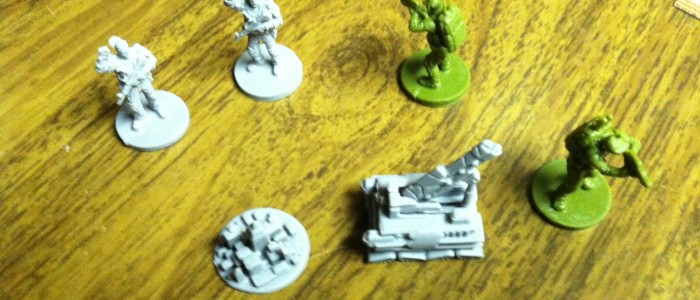
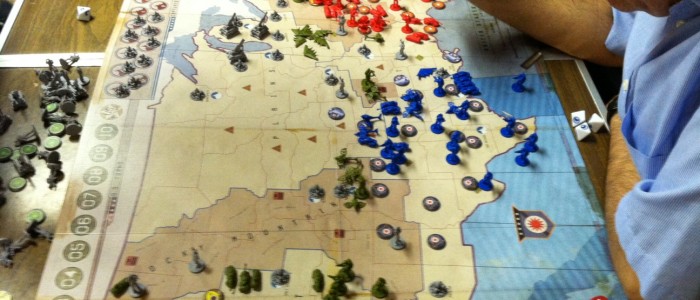
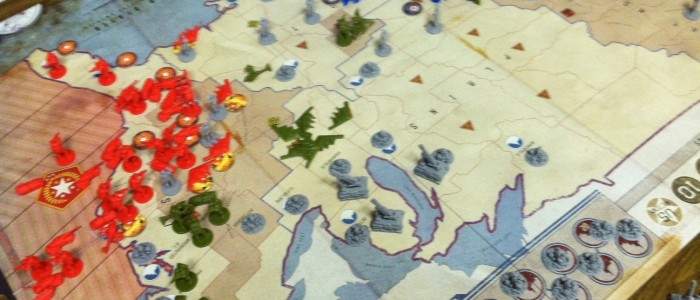
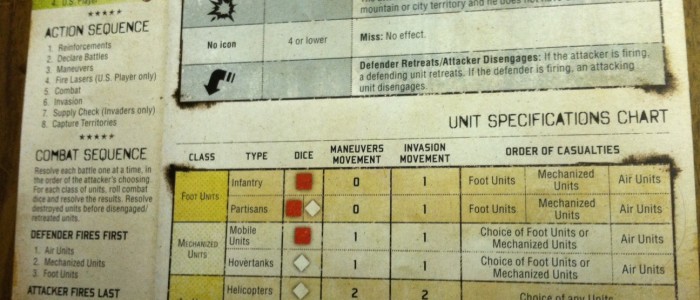
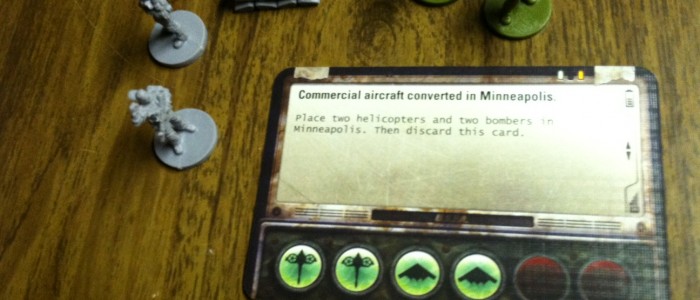
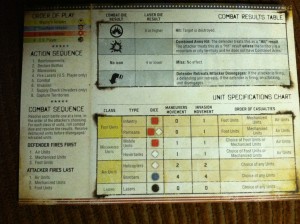
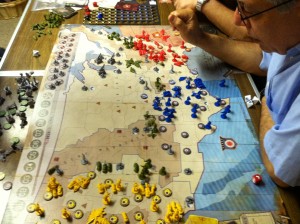
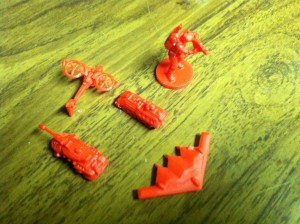




Excellent review and analysis, Fred! I have owned and played hundreds of wargames and Fortress America is by far my favorite.
Thanks for posting, Tex. We’ve played Fortress America occasionally since it came out. And it never lacks for players, although some new players dislike it because its hard (some say impossible) to win against experienced players. I just take that as an example of how well it’s designed. Perhaps Fortress America is just an acquired taste, but I find it one of the best light, American style, games available.